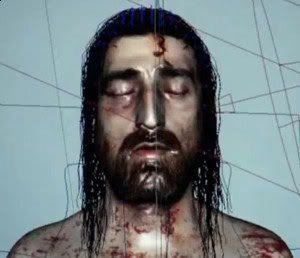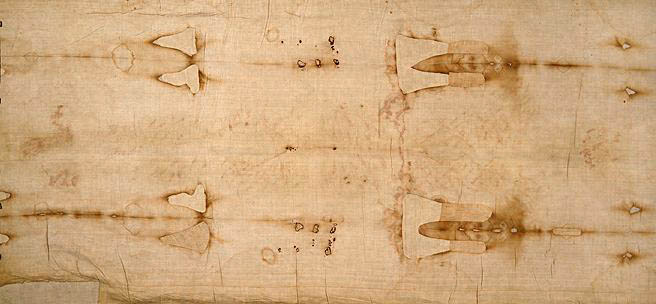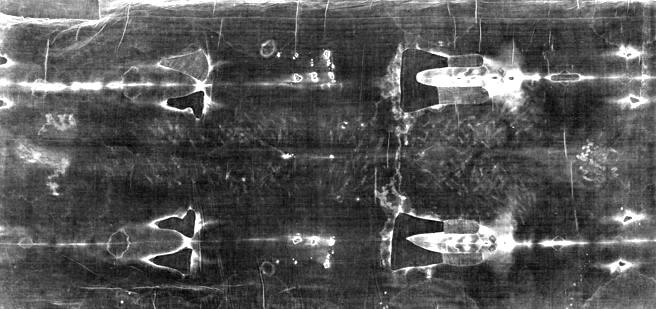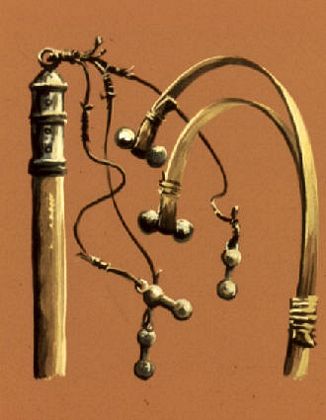
Posted on 02/28/2015 3:41:21 PM PST by NYer
All four gospels mention the burial cloth of Jesus Christ. The Shroud of Turin is believed by many to be that burial cloth. It is etched with the image of a man that was scourged, crowned with thorns, crucified, and lanced in the side. If it is real, it provides archeological evidence of the most consequential event in human history—the death and resurrection of Jesus Christ.
Pope Francis plans to venerate the Shroud this summer, just as his predecessors, Pope John Paul II and Pope Benedict did. The Pope has called for it to be displayed in Turin from April 19 to June 24 and he will view it personally on June 21. My husband Mark and I, and 6 of our 10 kids will make the trip there this spring. Thus, it was with particular interest that I previewed Examining the Shroud of Turin, the first segment of CNN’s 6-part series titled Finding Jesus: Faith, Fact, Forgery which will air this Sunday at 9 PM EST.
The documentary examines artifacts from the life of Jesus through worldwide experts in science, archeology, history and theology. The first episode asks: Is the Shroud of Turin the actual burial cloth of Jesus Christ or is it a fake?
If it is the burial cloth of Jesus, then it was Pontius Pilot who unwittingly began the journey of the Shroud as the most revered and controversial relic in history. It was he who gave Joseph of Arimathea permission to take down the body of Christ from the cross. Joseph donated his own burial cloth and tomb. He, together with Nicodemus–both prominent members of the Jewish ruling body, the Sanhedrin–took Jesus from the cross, wrapped him in linen and laid him in the tomb.
The historical records concerning the Shroud prior to the 14th century are not definite, opening its authenticity to question and leading some to call it a forgery. And so we must rely on scientific, historical, and archeological study to tell the story.
Candida Moss, Ph.D., a theology professor in New Testament and early Christianity at the University of Notre Dame was one of the consultants and commentators for the documentary. She has degrees from both Oxford and Yale and specializes in the study of relics, martyrdom, and the early Christian Church. Moss noted that evidence for the Shroud as truly the burial cloth of Jesus is very strong, but the Catholic Church has never definitively declared it so.
“When you look at Ecclesiastical statements made by the popes, they have never said the Shroud is authentic, but only that it’s worthy of veneration,” she said. “That is one of the things that the Catholic Church does well—to hold back and do their due diligence.”
The documentary explains that many who have dismissed the Shroud as a fake, point to the carbon dating in 1988. The testing dated the Shroud as coming into existence between 1260 and 1390. Scientists present those results in the film but other experts challenge that conclusion citing possible bacterial contamination of the cloth as has happened with burial shrouds from Egyptian Pharaohs. Carbon dating found them to be centuries younger than their actual known dates.
Another very powerful piece of evidence is presented: the Cloth of Oviedo. It is believed to be the cloth that was placed over the head of Jesus mentioned in the Bible. “Simon Peter, following him, also came up, went into the tomb, saw the linen cloth lying on the ground, and also the cloth that had been over his head; this was not with the linen cloth but rolled up in a place by itself” (John 20:6-7).
The history of this head covering, called the Sudarium, is well documented. It was taken from Palestine in 614 AD to Alexandria, through northern Africa and arrived in Spain in 616 AD where it remains today.
Both burial cloths have the same AB blood type. When compared to one another, the bloodstains match perfectly, showing that it came from the same man. It is noteworthy that the carbon dating on the Sudarium does not agree with that of the Shroud; showing the former as being many centuries older.
Another point against it being a forgery is the discovery that the image of the Shroud is actually a negative. The first photograph of it was taken by Secondo Pia in 1898. While looking at the negative image on the reverse photographic plate, all of a sudden he saw the positive image — he was staring at the face of Jesus! So if it was a fraud, someone would have had to think of creating the image in the negative.
“In looking at the material, I felt there was a lot more on scientific evidence that it could not be a forgery,” Moss said. “For instance, pollens were found on the cloth that came from Palestine and the placement of the nails were in the wrist.” She explained that in medieval times the crucified Christ was portrayed with nail marks in his palms, but historical and scientific research has shown that people were crucified in the wrist—the only possible way it could have held up the body. “If someone was going to make a forgery during that time, it would not have made sense to show the nail marks in the wrist.”
The most compelling evidence, according to Moss, is that despite attempts, no one has been able to recreate it. “When NASA scientists cannot make it, then who can?” she asked.
After the documentary airs, people will have the opportunity write in their questions on the CNN website and scholars will respond online. It premiers Sunday, March 1 at 9 PM EST.
Don't try to teach thousands of scientists their business, HiTech Redneck.
it's been done multiple times. The data encoded in the Shroud is quasi-3D. . . because it is neither a painting nor a photograph. What it is, is an analog two dimensional terrain map of the three-dminensional body the Shroud covered. . . created by an unknown modality that was completely vertically collimated with zero angular error. The intensity of the image is directly proportional to the cloth's distance from the body. The image density fades to the background color of the linen at the equivalent of about 2.5 centimeters. . . but computer enhancement of the color gradients has been able to extended that by almost triple the distance. Under enhancement, for example, I was informed principal light photographer of 1978's STURP scientific examination of the Shroud, that it can be seen that the Man on the Shroud is circumcised. Since the image carries quasi-3D data, it can do something no photograph or painting can do. . . be translated by a modern computer into a direct 3D model.


Thanks, CyberAnt. I am aware of it. I posted the link to it last year. I'm a friend of Barrie Schworz who appears in it, and who was the principal light photographer of STURP in 1978.
The nuns of the Sisters of Poor Claire who did the patching after the fire and mounted it on the Holland Cloth could not have been the ones who did the patching on the damaged corner that was later tested for C-14. There skills are no where up to the levels of the French invisible Reweaving that was performed on that corner. Whoever did that work was an artisan of the highest caliber, someone who had been trained for a lifetime under a master weaver, a person at the peak of his or her trade. The French Invisible Reweaving was mostly used to repair very expensive tapestries and Arrases so that the repairs could not be seen from either side.
It is thought the patch had to have been a repair to a corner which had become frayed from too much handling and hanging by either tying to ropes or even nails over the centuries (when STURP got possession of the Shroud in 1978, it had been fastened to a plywood backing with thumbtacks for the two weeks it had been on public exhibition!). It was probably done late in the 16th Century by someone under the direction of the King of Italy who could afford to hire the best.
Some of the Sanhedrin would have their bones kept separate, individual ossuaries for themselves and eventually their immediate families. And some were so full of themselves they want their bones to be separated from everyone and kept in the tomb by themselves in their own ossuary. These are found today. . . and one was found about 15 years ago that was claimed to have once contained the bones of James, son of Joseph, brother of Jesus. . . except the last had been scratched in, not carved.

The limestone box was later tracked backwards to an antiquities dealer who was known to alter antiquities to "enhance" their value. . . and sell other fakes. He was arrested and convicted of fraud.
Most of the ossuaries are from 2nd to 3rd century.
There were two possibilities. One was for a smaller sindon. . . much shorter than the one used for the Turin. It would just be laid over the body. The longer Shroud would be laid down, the body laid on it, the herbs and aromatic botanicals packed around it, and the balance of the cloth drawn over the head toward the feet in a reverse sheet arrangement. Occasionally, they might bind it with some bands, time permitting. The idea is to keep the body and packing together.
Think of Lazarus being able to walk out of his tomb still covered in his grave clothes. He could not have done such a thing were he swaddled in bandages or tied tightly.
Poor families could get by with just a face cloth covering and a modesty cloth on the groin area. . . but it was frowned on.
The word Sindon originally meant SAIL. . . to give you an idea of the size of cloth it could be and sometimes a used sail was used. Rich people used purpose bought cloths for grave clothes.
Nor did I say anything about the whole nine-yard rituals of Egyptian mummification, but the tight bindings that wrapping in strips that were conflated by the people of the 1700s to the Jewish burial customs would have taken far too long to be able to get a body into any tomb by sundown as well as doing the ritual washing, anointing, getting the herbs, oils, cloths, and make the deadline. The family attempting to do this are literally working with a dead weight. Then, when they return a year later, they would have to extract the bones from a mess of tangled cloth. Not practical at all.
A sindon represented about six weeks of someone's work. It was a very expensive product. Any cloth was expensive in that period. In fact, up until the invention of the powered loom, cloth was one of the most valuable things in an estate. In Dicken's "A Christmas Carol", the thieves were stealing the LINENS. . . over anything else in Scrooge's house when the Ghost of Christmas Future showed him the shadows of things to come. . . because at that time, they had more value than almost anything else.
2Co 5:7 (For we walk by faith, not by sight:)
I guess that's true with most Catholics...You see religious looking people, that must be the church...You see religious looking buildings, that must be the church...You see all those religious looking rituals, that must be the church...
Rom 14:4 Who art thou that judgest another man's servant? to his own master he standeth or falleth. Yea, he shall be holden up: for God is able to make him stand.
When that servant shows up on a public forum and claims that we are under the law, or that God's scripture is wrong or not enough; that Christians are not indwelt with the same Holy Spirit that a pope claims to have guiding him, and that his is the only true religion, then God expects us to stand up and shout...Shout to proclaim the biblical truth...
When God says there will be no signs given yet a religion comes up with signs and wonders to sway people to believe that their religion, which is contrary to scripture, is the true religion, then we are obligated to correct them with God's scripture...
They do repeat it often, so you may be in luck!
It’s from 2010, I think.
Agreed.
I think it has more to do with humility.
For later watching....thanks.
I might note that for centuries (from the time of the apostles and church fathers) there *was* only one true church.
Interestingly enough, and I had not ever heard this claim until a year or two ago, the oldest church might happen to be the Orthodox; the Roman bishop according to them, attempted to claim sole primacy; which claim was not accepted by all cities. Thus the first split in the West.
The Protestant reformation was open rebellion and schism; and while the printing press and the publication and distribution of Scripture in the common tongue helped counter some of the bureaucratic misuses of power by the Church, still many other evils were also unleashed.
I'm not going to get into a denominational argument here, except to note that many of the things I was confidently and arrogantly told of Catholics, turned out to be untrue.
I think greater humility on the part of ALL branches of the Church, should be the first step. Schism is not a great witness to unbelievers.
As far as your final remarks,
When God says there will be no signs given yet a religion comes up with signs and wonders to sway people to believe that their religion, which is contrary to scripture, is the true religion, then we are obligated to correct them with God's scripture...
Jesus Himself, in the gospels, told the Jews to believe because of His miracles: see John 10:38 and John 14:11.
And in the very next verse after John 14:11, Jesus told His disciples, “Truly, truly, I say to you, whoever believes in me will also do the works that I do; and greater works than these will he do, because I am going to the Father."
And miracles were a part of St. Paul's ministry.
So I cannot comprehend, nor follow, where you get your claim that "there will be no signs."
Second point. What do you mean "a religion comes up with signs and wonders" ?
For the Shroud itself, the reason it attracted so much notice is that it clearly *wasn't* a fake -- the fact that the image is a photographic negative, when photography wasn't invented until hundreds of years later; the image not being paint, but the results of a particular class of chemical reactions (Maillard reactions, known from cooking) with the soap residue left on the outer surface of the threads in the shroud, the 3-D nature of the image, the anatomical details which contradicted the 'knowledge' of the medieval period about crucifixion, the traces of hemoglobin breakdown products on the shroud, the traces of pollen left over from plants which grow in the vicinity of Jerusalem...
All of these put it out of the provenance of being a forgery: and hence the verb "comes up with" is inapplicable.
The reason the Catholics make a fuss over the Shroud, is that as far as they can tell, it is genuine, and a link to Jesus' resurrection. They don't INSIST on its being genuine, nor do they decree that it must be so as a matter of doctrine.
And miracles were a part of St. Paul's ministry.
Apparitions (or ghosts) are not miracles...They are signs/wonders, albeit false signs...
I would like to see specific examples of people bowing down and worshipping it. If you can't produce that, then the charges are worthless.
Where are the pictures of the back side ?
papists are always looking for a reason to believe..
What exactly were the grave clothes used of that time?
Thank you for your very detailed responses. It has been illuminating. I have been interested in the Shroud of Turin since 1978. I will have to reflect on your information.
Metmom Rnmomof7 is dodging question too.
I am assuming you are referring to the dorsal image, not the actual back of the cloth which has its own interest.
Here is a photograph of the dorsal image.


Close examination shows the wounds from the scourging from a Roman Flargrum, a flail with three leather straps ending in either two lead balls (lengthwise) or small dumbbells (crosswise). In the instance of the Man on the Shroud, it appears the two lead ball flagrum was used, which means six balls imbedded into the skin with each strike. As part of a class I taught on the Shroud, I made a reproduction flagrum and demonstrated it to the class. Striking it on a piece of pine lumber, each ball would imbed itself a half an inch deep into the wood! This was a very nasty weapon.

From the angles and heights of the wounds on the Shroud image, it is thought that there were two men inflicting the wounds, one on each side, one somewhat taller then the other.
I seem to recall that it was unusual (if ever) to flog a person AND hang them as punishment - do you recall? (If so, one more thing that coincides with the Biblical cruxifiction accout.) Also that it was often necessary to break the legs of those that were hanged, and the legs on the image are unbroken.
Hmm - just thinking, but I wonder if Christ died sooner rather than later because he knew that he had a purpose after this world. Whereas most people think that this is all there is, so try to hang on until the very end?
Of course he had also been beaten pretty badly, which would have weakened Him.
Disclaimer: Opinions posted on Free Republic are those of the individual posters and do not necessarily represent the opinion of Free Republic or its management. All materials posted herein are protected by copyright law and the exemption for fair use of copyrighted works.